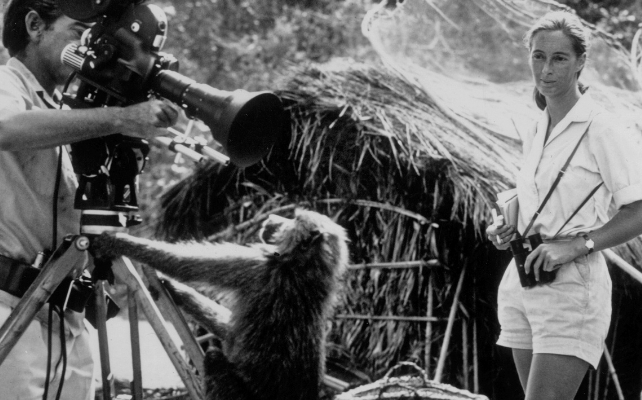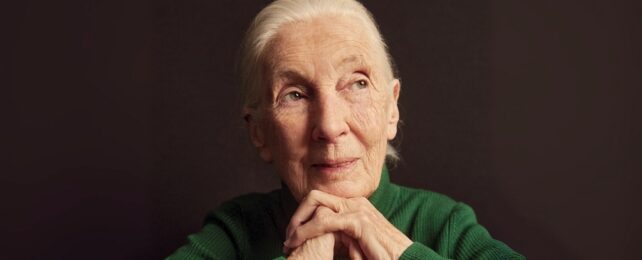Jane Goodall, one of the world's most beloved primatologists and conservationists, passed away from natural causes while in California as part of a US speaking tour.
She is survived by her son, Hugo "Grub" Van Lawick Jr., and his children.
In a moving tribute, the Jane Goodall Institute describes her as "passionate about empowering young people to become involved in conservation and humanitarian projects."
"She led many educational initiatives focused on both wild and captive chimpanzees. She was always guided by her fascination with the mysteries of evolution, and her staunch belief in the fundamental need to respect all forms of life on Earth," the institute notes.
Goodall helped discover much of what we now know about chimpanzee (Pan troglodytes) behavior, which revolutionized the way we think about humans and animals.
She has mentored generations of scientists, authored dozens of books, and was the subject of more than 40 films. Her Gombe chimp research project continues today as the longest-running study of wild animals in their natural habitat.
When Goodall began her work in 1960, scientists were expected to be completely detached from their subjects and study them from a distance. But Goodall brought a fresh perspective to science with her unconventional approach.

She would become a part of her subjects' lives and would name them rather than number them, a practice that she was widely criticized for. However, while Goodall acknowledged her methods had their flaws, they also allowed her to make trailblazing discoveries.
Her path into science was unique. It did not begin with formal training, although she did graduate later (in 1966) with a PhD in ethology, the study of animal behavior. Goodall's journey of discovery started with a passion for animals, a childhood dream to visit Africa, and secretarial school.
By age 23, she'd saved enough by working as a waitress to visit a friend's family in Kenya. There, she was encouraged to contact paleoanthropologist Louis S. B. Leakey, who hired her to do secretarial work. Leakey saw her scientific potential and asked her to take part in his primate behavioral research by studying chimpanzees in Gombe.
As she initially had no scientific training, Goodall used her instincts to conduct research, befriending the chimps so that they would allow her near enough for close observations. This led to her discovery that, just like humans, chimpanzees are capable of using and making tools.

"Now we must redefine tool. Redefine man. Or accept chimpanzees as human," Leakey exclaimed via telegram when she told him of her findings.
As Goodall explained in the 2017 National Geographic documentary Jane, before this time, the prevailing scientific view was that only humans had minds and were capable of rational thought. The idea that other animals could possess any kind of human-like intelligence was almost blasphemous.
"Fortunately, I'd not been to university and I did not know these things," she said.
The male-dominated scientific community met her discovery with sexism, skepticism, and derision. But Goodall persevered, tolerating unwanted attention as National Geographic's cover girl in exchange for their support.
Her unconventional methods of relating to her scientific subjects and sharing their personalities with the world helped capture the hearts of the public and also demonstrate the value of diversity in science.

Goodall used her status as a public figure to fight relentlessly for the conservation of chimpanzees, setting up The Jane Goodall Institute in 1977. From 1986 onwards, she travelled the world to encourage future generations to become better stewards of our living planet. She was also a fierce humanitarian:
"We can't leave people in abject poverty, so we need to raise the standard of living for 80 percent of the world's people, while bringing it down considerably for the 20 percent who are destroying our natural resources," she told the World Summit on Sustainable Development in 2002.
Through her program Roots and Shoots, Goodall both inspired and provided hope for younger generations who feared for their future. She staunchly supported the current environmental movements driven by young people.
"I do have reasons for hope: our clever brains, the resilience of nature, the indomitable human spirit, and above all the commitment of young people empowered to take action." -Climate One guest Dr. Jane Goodall & @GretaThunberg @wef #Davos @JaneGoodallInst 📸 cred: Jeff Horowitz pic.twitter.com/vPXSwBYTkF
— The Climate One Podcast (@climateone) March 4, 2019
As a determined young researcher, Goodall showed the world that there is an important place for emotion, empathy, and advocacy in science - traits still required to both obtain support for and create impact with environmental sciences today.
Her work not only revolutionized her own areas of study, but the wider world of science itself. She helped to shatter the cold, detached, white-coated male stereotype of a scientist by providing a shining example of what women can achieve if given the opportunity.
In doing so, she inspired countless young people around the world to pursue science, including those who now carry on her research in Gombe. Her legacy will continue to do so for years to come.
"Only if we understand, can we care. Only if we care, will we help. Only if we help, shall we be saved." - Jane Goodall, Jane Goodall: 40 Years at Gombe
